With the following free tools you can do your own keyword research, for free.
5 Free tools for your keyword research:
- Google Ads keyword planner (free)
- Google Search Console (free)
- Ubersuggest (free)
- Yoast suggestion (free)
- Bing Webmaster Tools Keyword Research (Free)
But before you dive into these 5 tools, please read the following, first:
Research first, then optimize your content!
Before you start your keyword research, remember that you are only researching possible search terms for which you want to be found, not the other way around!
- What kind of search results are there now on page 1 for that keyword? (is there a featured snippet? Are there videos, how many ads)
- Who exactly are your competitors for that keyword?
- Does your page fit well among the search results on page 1?
- Is it useful to get your content on page 1? Does it fit in with the rest of the articles? Is it better than the competition?
- How difficult is it to rank high?
- Do you know enough about the subject?
- Do you have enough time to research the topic and write the article?
Ask yourself this question: Why?
Ask yourself this question honestly. Why do you want to rank for a specific keyword?
Be honest.
Is it just to share some information? Is it a passion? Is it part of your Sales Funnel to get more customers? Is it to keep your own knowledge up to date? These can be excellent reasons.
Another reason could be that your competitor is ranking for that keyword!
But don’t forget this: Writing a new article takes time and if you need to hire someone, it will also cost money. So ask yourself this question:
For what purpose am I writing the article ?
The next question is perhaps even more important: What exactly is the intent of the keyword? This means, what is the ‘reason’ people search for this?
Just an example:
Suppose you have an online store for large-size men’s shoes. You will have more success ranking for “plus-size men’s shoes ” than for a generic search query such as “ men’s shoes.”
For ( men’s shoes ) it will cost you a lot of money to rank higher in Google. As a result, you probably can’t even sell your ‘large sizes’, because people weren’t looking for them.
Pro TIP : Focus more on specific rather than general searches. Firstly, it is much easier to score on that and secondly, you have a better chance of conversions.
We will return to this question later.
Start brainstorming for search terms and topics
First decide what the main subject should be for the page. (You should really only choose 1 topic per page, not: shoes and slippers)
Open your favorite spreadsheet software such as Microsoft Excel or Google Sheets (the latter is my preference). But a sheet of paper or an old-fashioned notepad is also completely fine. Now start writing down some words or sentences about the topic. Only when you get stuck do you start using software and tools.
If you can’t figure it out, look here:
- Your competition’s websites
- Wikipedia: search for your topic and read the text
- Check out some online forums that discuss the topic
- Don’t forget that there is a Facebook group for every topic, otherwise, there is Reddit
- View the questions asked on Quora
- Use a website like synonyms.net for a list of synonyms that might offer new angles.
You may think that these are tools, but these are not the tools I mean.
Why start with a manual investigation?
PRO TIP: The above list will only keep you busy. Manual research also has an additional advantage that few people talk about. In forums people often talk about the latest news or products that keyword tools do not yet show.
During this research, you will always find something interesting to write about, especially if you just take your time. That is why doing your own research is so important, but unfortunately, it is sometimes difficult to explain to the customer when you are being paid for it.
Now that you know the subject, let’s cheat a little, and read your competitors’ articles thoroughly—all 10 on page 1. You may be amazed at what they are writing about. And you will know what your are up against.
Extra: this way, you also get an idea of how your competition is doing in terms of SEO. That is also not unimportant to know.
It’s now time to use some keyword tools
Did you read all of the above?
You don’t have to do all the brainstorming, and visiting your competitors, but it is beneficial. You can learn a lot from doing this, before using any tool or software.
Keyword tools take a lot of the guesswork out of your keyword research, so use their data to your advantage. They give you the search volume (number of times that keyword is searched per month) and often also the difficulty of ranking.
With the following tools you can get a lot of keyword ideas in a short time.
(1) Google Keyword Planner (free for Google Ads users)
How do you use the keyword planner?
The Google keyword planner is built into Google Ads. That’s why you need a Gmail account. Sign up for Google Ads here .
Remember that Google Ads is mainly used for advertisers, so quite a few search terms do not appear in it. Especially if it is a question or the search term contains multiple words.
We use this Google keyword planner to find relevant search terms for keyword research. Suppose you want to write about large size men’s shoes, Google will provide all kinds of variations of that keyword. For example, Google shows how often that keyword is searched and provides words related to the keyword.
There is also a disadvantage.
You will not see complete data with complete numbers. If you have no current advertisements, it shows rounded numbers. Instead of a search volume of 580, she now shows 100-1000, so somewhere between 100 and 1000.
So, it’s not very clear always.
If you want to see specific numbers, you need an active advertising campaign of a few euros per day. Then you will see all the numbers. And if you even set it up, you can also learn which keywords really convert.
Note: Another disadvantage of this tool is that it only shows search terms on which you can advertise. Google is not a charity, and it also wants to make money. So they only show keywords that they can make money from. This is therefore a huge disadvantage for your research! This way you miss all kinds of long questions or sentences that the Keyword Planner does not show.
Go to https://ads.google.com/ and log in.
Then go to Tools-Keyword Planner.
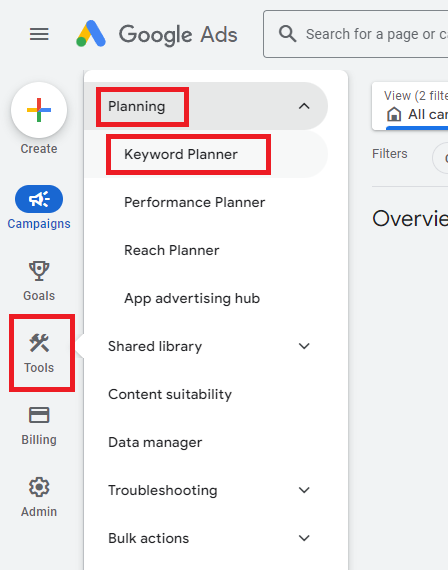
Please note: When you log in for the first time, you must enter your payment details and start a campaign. Just follow those steps, and then put the campaign on Pause… then you can just use the tools. But you have to go through those start-up procedures.
Then click on Discover new keywords. Let me take online marketing as an example. A well-known keyword when you are involved in SEO! We are here to become easier to find online, which is why our keyword is now ‘online marketing’.
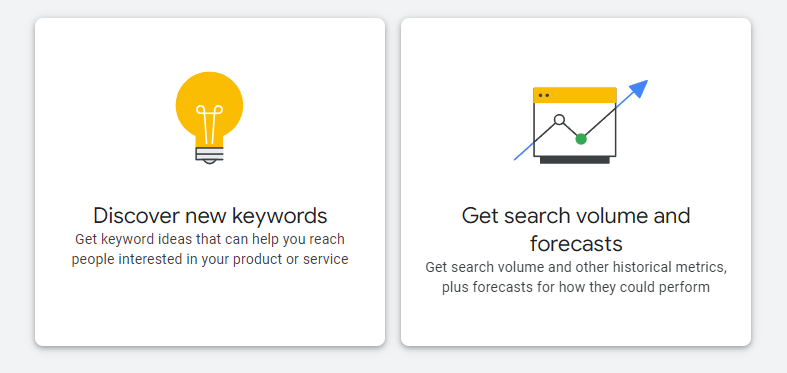
You can then also sort the search terms by search volume to keep your keyword research extra clear. This means that the most searched words will appear at the top, and are probably also the most interesting to you. You can then also download this entire list to open in the spreadsheet.
PRO TIP:
The CPC (cost per click) column gives a kind of indication of the value of a word. Because the words with a higher CPC are most likely also the words that generate the most revenue for advertisers! They don’t cost so much for anything because advertisers are also willing to pay for such a click! This does NOT mean that it is always harder to rank higher in the search results! Although that correlation is certainly there.
(2) Google Search Console: a true goldmine
If your website has been around for a long time and you already have quite a bit of content on your website, it is also a great tool for getting ideas. It is a real goldmine for SEO.
It may happen that a word or phrase in the text has been picked up by Google and shown in the search results. You can use this for new ideas or optimize the current content. I’ve already gotten a lot of ideas from this.
Do as follows:
1. Go to https://search.google.com/search-console?
2. Go to Performance, Search results , click New, and enter a search query. The search list will then show all the terms and phrases your website has ever appeared on. Don’t forget to set the DATE to 6 months or 12 months to get EVEN more ideas.
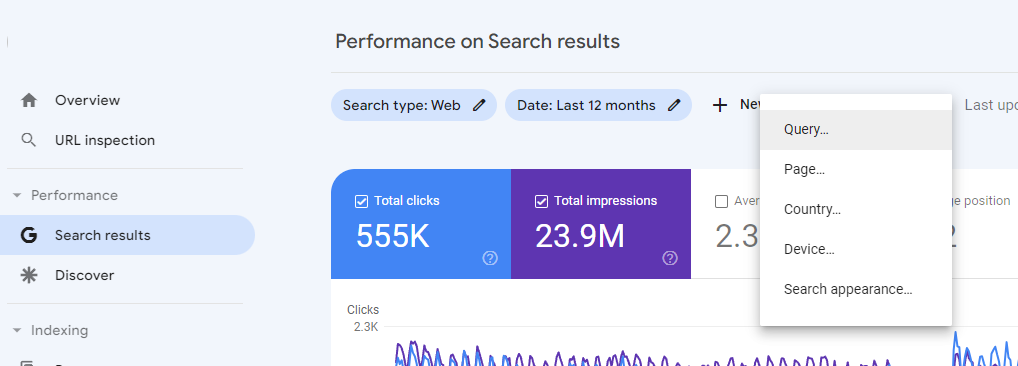
You can then add this list to your spreadsheet’s previous list.
But you can go one step further and see which keywords a particular page is found for. Here you often see synonyms and other relevant keywords. Actually, it’s even better than above.
- Go to Performance
- Go to the Pages tab
- Choose the page
- Then click Searches
Then, you will see exactly the keywords for that page. Super handy.
(3) Ubersuggest (limited free)
How do you use Ubersuggest?
This can be a much better alternative to Google Keyword Planner. You can use Ubersuggest immediately without having to fill in all kinds of information first and set up an advertising budget.
Finally, it also works better because you don’t get rounded numbers (which you get with an account without ongoing Google Ads campaigns) but specific numbers, so there is no search volume of 10-100 or 100-1000, but simply 510 or 1480!
And the best part is that Ubersuggest simply uses the keyword planner for its data! So you kill 2 birds with 1 stone.
Unfortunately, Ubersuggest still has a few catches, but I will return to that later.
This is how you can use ubersuggest:
- Go to https://app.neilpatel.com/nl/ubersuggest/
- Enter a keyword
- Choose the correct country
- Click on search
The tool will do a quick search and then show you an overview of keywords related to your topic. See the image below as an example. Here you can see what the average monthly search volume is, and you also see the search volume per month. This is super useful because you can quickly see whether the word is not searched for more often in one month than in another month. Suppose you sell Christmas gifts, the average search volume will be MUCH lower than the actual search volume in November and December. This is like a pro tip.
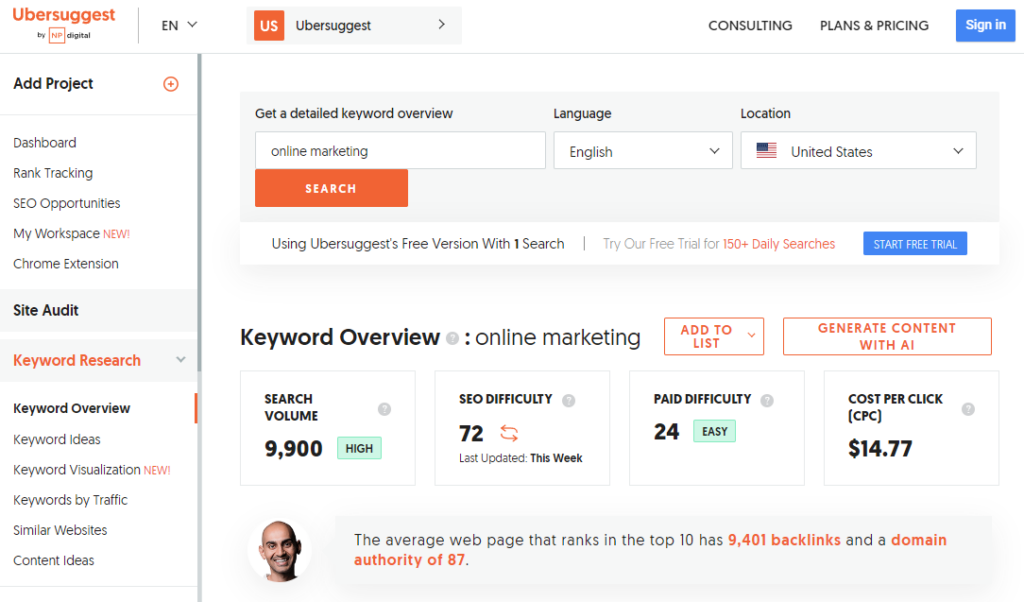
On the left side you have even more options, and when you choose keyword ideas, you get an extremely useful overview with all kinds of terms related to your search term. In most cases, these are terms that are directly related to your topic.
We will soon come back to another type of words, namely LSI (which is actually not the correct name) or related terms that come up when you talk about a certain subject.
Read about that further down…
The great thing about keyword ideas is that you can easily download the list and add it to your spreadsheet for your keyword research!
Find out where your competitor is found
There is one more tool available within Ubersuggest that is absolutely great! You can enter a competitor’s domain name and find a whole list of keywords that your competitor is currently being found for! Normally this option is only available in affordable tools such as Ahrefs, Semrush, SkypFu, Moz etc!
But those tools can easily cost you 100 euros per month.
And ubersuggest now offers this feature completely free, but on a limited basis! That’s why this is one of the best free keyword tools in the SEO world.
Traffic Analysis – Keywords
The tool we are talking about is simply called keywords. See the image below where you can find them. Once you have this list you can download it again and add it to your Spreadsheet!
If the list has thousands of keywords, it may be a bit long; you can always filter them by search volume!
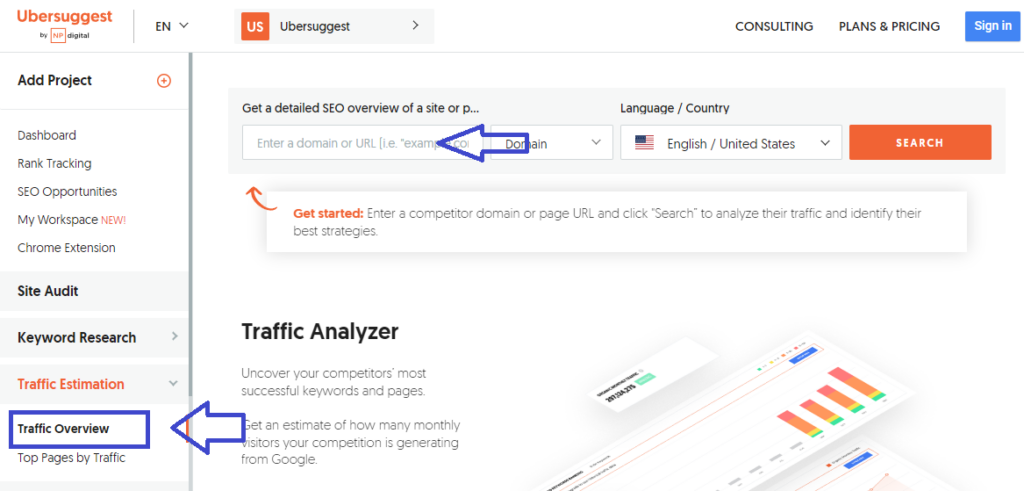
(4) Yoast Suggest (Useful for long-tail keywords)
If you thought you had finally mastered all the tools, one more tool comes into play for your keyword research.
Yoast Suggest actually works a bit like Ubersuggest. Both suggest keywords. Instead of looking at the keywords from the keyword planner, Yoast looks at the keywords in Google’s own autocomplete, as in this image. The words that emerge are often long-tail keywords , which we have written about before. (long tail keywords)
Both words that come after the keyword and keywords that appear before the keyword are included in Yoast Suggest. You can use Yoast Suggest here . There are also other variants, but they are usually in English, such as keyword.io and keywordtool.io
The list you get can also be very long, and the handy thing about Yoast Suggest (actually just like every other tool mentioned here) is that you can export it!
After exporting, you can then add it to the spreadsheet for browsing. Unfortunately, no further data is available such as search volume or difficulty to rank in the search results!
- Enter your keyword
- Select the correct language
- Check Output a CSV if you want to download the list!
- Click Submit
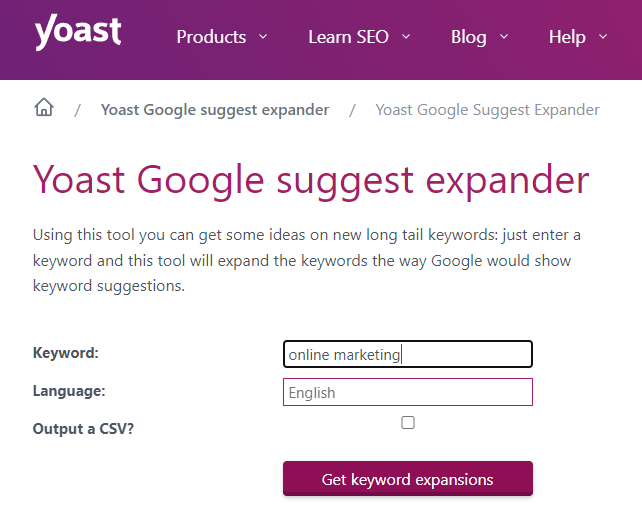
(5) Bing Keyword Research
Keyword research with Bing webmaster tools (the neglected child)
This is one of the least known sources for your keywords, but certainly not a bad one to include in your keyword research. Bing is still an important but small player in the search engine world, so you better make use of it. Especially since Bing built in ChatGPT.
Because it’s free!
Although not nearly as big and extensive as Google, it can still be used as a free keyword research tool and as part of your SEO arsenal.
In my opinion, you should always register for Bing Webmaster if you want to be serious about SEO or online marketing in general. An average of 5-10% of all searches are still done via Bing.
And why would you ignore 5-10% of your visitors if they can enter for free?
Register and link your website to Bing Webmasters with a small effort. Then, submit your Sitemaps, and you’re done.
Get more ideas with Bing Keyword Tool
Log in to your Bing Webmasters account: https://www.bing.com/toolbox/webmaster
- In the left panel, go to Keyword Research
- Type the keyword you would like to receive more keyword ideas for
- Don’t forget to set the country
- Also, set the language to find the right keywords, this is especially important for words that they also use abroad
- Select 6 months to receive even more data
- And then click SEARCH
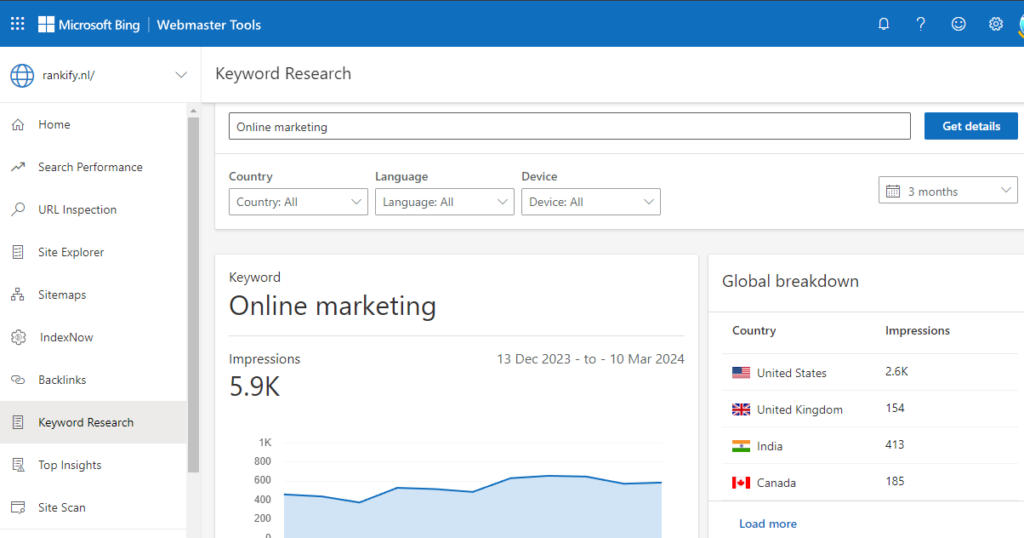
Now that you see the entire list of keywords, you can also sort them by search volume. You do this by clicking on the word: Appeared in Search above the columns.
As soon as you click on it, the list will sort itself from high to low search volume.
Remember to export (download) this list again and then add it back to your spreadsheet. At this point, you should have a whole list of keywords in your list.
PRO TIP:
It’s funny to hear, but Bing also has a backlink option. Here, you can see which backlinks your competitors have. Google would never do this, but Bing does.
Don’t know what backlinks are? Read this: What is a backlink?
Hang in there, we’re almost done with the keyword research. Now for the search volumes!
You can start striping and highlighting once you have the lists in your Excel sheet. I always recommend running the entire list of possible keywords through Google Ads keyword planner again to see the monthly search volume!
- Go to ads.google.com
- Go to Keyword Planner
Then select Search Volume and View Forecast, as you can see in the image above. Then add all your keywords that are interesting. You can also upload an entire list from a file here! The only problem is that you have to do that in a certain format, and copying and pasting the list is usually faster!
Once they load, you can choose Historical data, download the entire list again and open it in a spreadsheet. Now you also have the data you have from the other tools in the same overview! Now you can start germinating and choosing which are the best keywords for you!
One last thing: don’t forget your LSI keywords/NLP/entities!
Create 1 new tab in your spreadsheet for the LSI keywords. (Latent semantic indexing).
Officially, they are not real “LSI keywords”, but this is a term that has become somewhat ingrained in the SEO world, so that’s why I’m just using it.
These words have become indispensable parts of search engine optimization and, therefore, of your keyword research. LSI keywords are terms that can automatically come up when you talk about a certain topic. So, these are words that you often hear within a certain context.
For example, if you are having a conversation about SEO, there are words you would probably mention such as: websites, WordPress, link building, 301, SEA etc.
These are the relevant and contextual words we mean by this. We don’t mean synonyms. When you know a lot about a certain subject, you will automatically add these words to the text!
That is why it is wise to have someone write about a subject who also knows a lot about it , then those related terms will be included automatically! For people like me, who are not very good at writing texts and are not very creative but are more concerned with data, there are tools that can help you with this.
To find relevant words for your text, you can use LSIgraph.com or https://lsikeywords.com. Unfortunately, both are not very good at adding new words, but you can pick out one or two!
In addition, I think http://semantic-link.com/ is a good tool that shows really special words that are certainly related to the subject! The only drawback, however, is that it is only in English.
I personally use paid tools such as Page Optimizer Pro and Cora SEO to obtain the LSi words. Unfortunately, both tools are not free. Cora looks at the top 100 positions for a specific keyword and sees which words keep recurring on the pages in the top search results.
POP (page optimizer pro) looks at the pages of your competitors that you have specified to see which words appear most often on all those pages, and shows them in an overview.
Ok, now you can almost start writing your page!
Well done. You now have everything for your keyword research. But what are the best words to use? Before we look at the difficulty of scoring high on Google, I would first like to draw your attention to something else: the intent of the keywords.
You don’t have to hire a copywriter to score high, but a copywriter can certainly help with conversions.
What is the intention behind the search?
It’s great that you’re at the top for ‘replacing your own windshield wipers’, but what good is it if you’re a car dealer?
Although there is something to be said for the number of rankings in the search results, when choosing a keyword, you should consider what exactly a searcher would like to find. The simplest and also the best way is to simply Google the word . As soon as you have the search results in front of you, you can already see what Google thinks is important.
Google is quite smart in that it tries to show search results that searchers find helpful. They, therefore, answer their question or problem. If you want to know whether the keyword is becoming more popular or less popular, use Google Trends.
Therefore, Google the word and look at the Titles and Meta descriptions of the search results. Your keyword research does not only focus on the words but also on their meaning, or in other words, the intention behind the search query.
If you are sure that the search results match what you would like to achieve (with that keyword), you can highlight the keyword in your spreadsheet!
Which keyword should I choose now?
I now recommend checking it for difficulty. For example, use KWfinder, Serpstat, or Moz Keyword Explorer for this! All these tools have a free version in addition to the paid version.
The free version often only shows you a small number of keywords with a difficulty number. This allows you to estimate how difficult it is to rank ahead.
Moz keyword explorer gives you 10 monthly searches to see how difficult a keyword is. So be careful with this, because 10 words is not very much. But every search spits out a whole list of similar keywords. There could be as many as 1000.
The other tools simply show a shorter list of keywords. What is useful about Serpstat is that you can, for example, add a filter or sort by a different segment so that you can still view some other keywords.
Unfortunately, all of these tools use a different difficulty scale. But what I often take into account is the MOZ difficulty level. If it is below 30, you can expect it to take about 2-3 months to get to the second page. Of course, this depends on the authority of your website and the number of backlinks and media coverage you will receive in the meantime.
Other ways to check how difficult it is to perform a search in Google with special Google Search Operators such as “keyword” (in quotes) or intitle:yourkeyword (which only finds pages that have the keyword in the Title. If you want to know more about these Search Operators, you can follow this guide from Ahrefs for now .
Here you have a step-by-step plan that you can follow to see what the intention is, and how difficult it is.
- Search for the keyword in Google or Bing
- See who the competitors are (also visit the pages)
- See how much content they have. (How many words) Use, for example, Surfer SEO or Page Optimizer PRO for this. (read the reviews to see how they work)
- Estimate how long it will take to get to the 2nd page by searching the keyword in Moz, Serpstat, Ubersuggest or another tool.
- Check how many backlinks the pages that are now in the top 10 have.
Then choose a keyword that best fits the intention of the search query, and has a not too high difficulty level, but still sufficient search volume (such as 20+). This is not always easy and can take some time.
And start writing!
Don’t forget to add the LSI and synonyms in your text!
Good luck!


